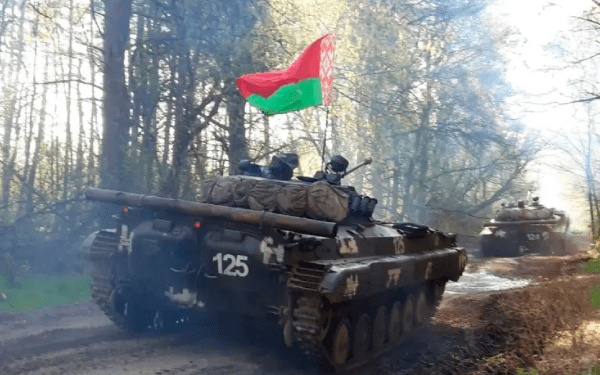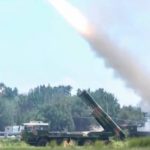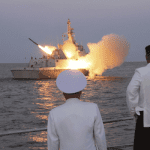Belarus has resumed military exercises along its border with Poland and Lithuania, as tensions rise between the two NATO members over Russia-linked Wagner mercenaries who relocated to Belarus following their brief revolt in Russia.
Poland and Lithuania have tightened border security since thousands of Wagner fighters arrived in Russia-allied Belarus in late June as part of a settlement that ended their armed insurrection and allowed them and their commander, Yevgeny Prigozhin, to avoid criminal charges.
The leaders of the two NATO nations have stated that they are bracing for provocations from Moscow and Minsk in a sensitive area where both countries border Belarus and the Russian exclave of Kaliningrad. The remarks were made early in August after two Belarusian helicopters flew quickly and low into altitude into Polish airspace. Belarusian authorities denied their helicopters entered Poland.
The Belarusian defense ministry said the drills that began on Monday are based on experiences from “the special military operation”
The war exercises took conducted in Belarus’ Grodno area, near the so-called Suwalki Gap, a sparsely populated piece of land that runs 96 kilometers (60 miles) along the Polish-Lithuanian border.
Belarus’ military has stated that it actively uses Russian mercenaries to train its troops, and the exercises began as more Wagner fighters apparently arrived in the nation. Mercenaries arrive in tiny batches every day, according to Belaruski Hajun, an activist organization that monitors troop movements in Belarus.
Belarus has resumed military exercises along its border with Poland and Lithuania, as tensions rise between the two NATO members over Russia-linked Wagner mercenaries who relocated to Belarus following their brief revolt in Russia.
Poland and Lithuania have tightened border security since thousands of Wagner fighters arrived in Russia-allied Belarus in late June as part of a settlement that ended their armed insurrection and allowed them and their commander, Yevgeny Prigozhin, to avoid criminal charges.
The leaders of the two NATO nations have stated that they are bracing for provocations from Moscow and Minsk in a sensitive area where both countries border Belarus and the Russian exclave of Kaliningrad. The remarks were made early in August after two Belarusian helicopters flew quickly and low into altitude into Polish airspace. Belarusian authorities denied their helicopters entered Poland.
The Belarusian defense ministry said the drills that began on Monday are based on experiences from “the special military operation”
The war exercises took conducted in Belarus’ Grodno area, near the so-called Suwalki Gap, a sparsely populated piece of land that runs 96 kilometers (60 miles) along the Polish-Lithuanian border.
Belarus’ military has stated that it actively uses Russian mercenaries to train its troops, and the exercises began as more Wagner fighters apparently arrived in the nation. Mercenaries arrive in tiny batches every day, according to Belaruski Hajun, an activist organization that monitors troop movements in Belarus.
Belarus has resumed military exercises along its border with Poland and Lithuania, as tensions rise between the two NATO members over Russia-linked Wagner mercenaries who relocated to Belarus following their brief revolt in Russia.
Poland and Lithuania have tightened border security since thousands of Wagner fighters arrived in Russia-allied Belarus in late June as part of a settlement that ended their armed insurrection and allowed them and their commander, Yevgeny Prigozhin, to avoid criminal charges.
The leaders of the two NATO nations have stated that they are bracing for provocations from Moscow and Minsk in a sensitive area where both countries border Belarus and the Russian exclave of Kaliningrad. The remarks were made early in August after two Belarusian helicopters flew quickly and low into altitude into Polish airspace. Belarusian authorities denied their helicopters entered Poland.
The Belarusian defense ministry said the drills that began on Monday are based on experiences from “the special military operation”
The war exercises took conducted in Belarus’ Grodno area, near the so-called Suwalki Gap, a sparsely populated piece of land that runs 96 kilometers (60 miles) along the Polish-Lithuanian border.
Belarus’ military has stated that it actively uses Russian mercenaries to train its troops, and the exercises began as more Wagner fighters apparently arrived in the nation. Mercenaries arrive in tiny batches every day, according to Belaruski Hajun, an activist organization that monitors troop movements in Belarus.
Belarus has resumed military exercises along its border with Poland and Lithuania, as tensions rise between the two NATO members over Russia-linked Wagner mercenaries who relocated to Belarus following their brief revolt in Russia.
Poland and Lithuania have tightened border security since thousands of Wagner fighters arrived in Russia-allied Belarus in late June as part of a settlement that ended their armed insurrection and allowed them and their commander, Yevgeny Prigozhin, to avoid criminal charges.
The leaders of the two NATO nations have stated that they are bracing for provocations from Moscow and Minsk in a sensitive area where both countries border Belarus and the Russian exclave of Kaliningrad. The remarks were made early in August after two Belarusian helicopters flew quickly and low into altitude into Polish airspace. Belarusian authorities denied their helicopters entered Poland.
The Belarusian defense ministry said the drills that began on Monday are based on experiences from “the special military operation”
The war exercises took conducted in Belarus’ Grodno area, near the so-called Suwalki Gap, a sparsely populated piece of land that runs 96 kilometers (60 miles) along the Polish-Lithuanian border.
Belarus’ military has stated that it actively uses Russian mercenaries to train its troops, and the exercises began as more Wagner fighters apparently arrived in the nation. Mercenaries arrive in tiny batches every day, according to Belaruski Hajun, an activist organization that monitors troop movements in Belarus.
Belarus has resumed military exercises along its border with Poland and Lithuania, as tensions rise between the two NATO members over Russia-linked Wagner mercenaries who relocated to Belarus following their brief revolt in Russia.
Poland and Lithuania have tightened border security since thousands of Wagner fighters arrived in Russia-allied Belarus in late June as part of a settlement that ended their armed insurrection and allowed them and their commander, Yevgeny Prigozhin, to avoid criminal charges.
The leaders of the two NATO nations have stated that they are bracing for provocations from Moscow and Minsk in a sensitive area where both countries border Belarus and the Russian exclave of Kaliningrad. The remarks were made early in August after two Belarusian helicopters flew quickly and low into altitude into Polish airspace. Belarusian authorities denied their helicopters entered Poland.
The Belarusian defense ministry said the drills that began on Monday are based on experiences from “the special military operation”
The war exercises took conducted in Belarus’ Grodno area, near the so-called Suwalki Gap, a sparsely populated piece of land that runs 96 kilometers (60 miles) along the Polish-Lithuanian border.
Belarus’ military has stated that it actively uses Russian mercenaries to train its troops, and the exercises began as more Wagner fighters apparently arrived in the nation. Mercenaries arrive in tiny batches every day, according to Belaruski Hajun, an activist organization that monitors troop movements in Belarus.
Belarus has resumed military exercises along its border with Poland and Lithuania, as tensions rise between the two NATO members over Russia-linked Wagner mercenaries who relocated to Belarus following their brief revolt in Russia.
Poland and Lithuania have tightened border security since thousands of Wagner fighters arrived in Russia-allied Belarus in late June as part of a settlement that ended their armed insurrection and allowed them and their commander, Yevgeny Prigozhin, to avoid criminal charges.
The leaders of the two NATO nations have stated that they are bracing for provocations from Moscow and Minsk in a sensitive area where both countries border Belarus and the Russian exclave of Kaliningrad. The remarks were made early in August after two Belarusian helicopters flew quickly and low into altitude into Polish airspace. Belarusian authorities denied their helicopters entered Poland.
The Belarusian defense ministry said the drills that began on Monday are based on experiences from “the special military operation”
The war exercises took conducted in Belarus’ Grodno area, near the so-called Suwalki Gap, a sparsely populated piece of land that runs 96 kilometers (60 miles) along the Polish-Lithuanian border.
Belarus’ military has stated that it actively uses Russian mercenaries to train its troops, and the exercises began as more Wagner fighters apparently arrived in the nation. Mercenaries arrive in tiny batches every day, according to Belaruski Hajun, an activist organization that monitors troop movements in Belarus.
Belarus has resumed military exercises along its border with Poland and Lithuania, as tensions rise between the two NATO members over Russia-linked Wagner mercenaries who relocated to Belarus following their brief revolt in Russia.
Poland and Lithuania have tightened border security since thousands of Wagner fighters arrived in Russia-allied Belarus in late June as part of a settlement that ended their armed insurrection and allowed them and their commander, Yevgeny Prigozhin, to avoid criminal charges.
The leaders of the two NATO nations have stated that they are bracing for provocations from Moscow and Minsk in a sensitive area where both countries border Belarus and the Russian exclave of Kaliningrad. The remarks were made early in August after two Belarusian helicopters flew quickly and low into altitude into Polish airspace. Belarusian authorities denied their helicopters entered Poland.
The Belarusian defense ministry said the drills that began on Monday are based on experiences from “the special military operation”
The war exercises took conducted in Belarus’ Grodno area, near the so-called Suwalki Gap, a sparsely populated piece of land that runs 96 kilometers (60 miles) along the Polish-Lithuanian border.
Belarus’ military has stated that it actively uses Russian mercenaries to train its troops, and the exercises began as more Wagner fighters apparently arrived in the nation. Mercenaries arrive in tiny batches every day, according to Belaruski Hajun, an activist organization that monitors troop movements in Belarus.
Belarus has resumed military exercises along its border with Poland and Lithuania, as tensions rise between the two NATO members over Russia-linked Wagner mercenaries who relocated to Belarus following their brief revolt in Russia.
Poland and Lithuania have tightened border security since thousands of Wagner fighters arrived in Russia-allied Belarus in late June as part of a settlement that ended their armed insurrection and allowed them and their commander, Yevgeny Prigozhin, to avoid criminal charges.
The leaders of the two NATO nations have stated that they are bracing for provocations from Moscow and Minsk in a sensitive area where both countries border Belarus and the Russian exclave of Kaliningrad. The remarks were made early in August after two Belarusian helicopters flew quickly and low into altitude into Polish airspace. Belarusian authorities denied their helicopters entered Poland.
The Belarusian defense ministry said the drills that began on Monday are based on experiences from “the special military operation”
The war exercises took conducted in Belarus’ Grodno area, near the so-called Suwalki Gap, a sparsely populated piece of land that runs 96 kilometers (60 miles) along the Polish-Lithuanian border.
Belarus’ military has stated that it actively uses Russian mercenaries to train its troops, and the exercises began as more Wagner fighters apparently arrived in the nation. Mercenaries arrive in tiny batches every day, according to Belaruski Hajun, an activist organization that monitors troop movements in Belarus.














